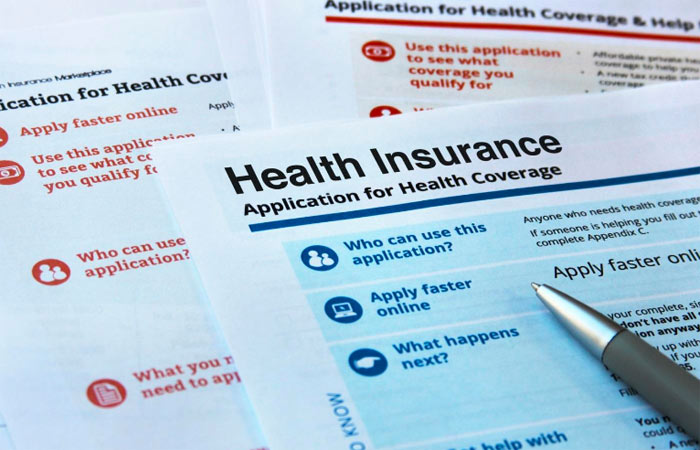Health insurance can be a tricky thing for anyone to figure out. But when you’re not able to use your parents’ plan anymore and you’re navigating the application process for the first time, it becomes even more complicated.

How can you be sure that you’re getting the best deal?
Is health insurance really as expensive as it seems?
These are just a few of the questions that may come up as you learn how to choose health insurance. Luckily, you don’t have to figure everything out alone. There are plenty of resources you can use to guide you through the process – like this guide!
Here are all the steps you need to take when choosing a health insurance plan.
1. Consider Employer Health Insurance vs. Marketplace Health Insurance
Before you get into the nitty-gritty of different health insurance plan options, you have to decide whether you want to apply for your own insurance or use the plans available through your employer. Each course of action has its own pros and cons.
Going through your employer is the more straightforward way of doing things. Your options are already narrowed down for you and the process tends to be easy to understand.
Plus, you can talk to your coworkers about their experiences with different plans provided by the company and reach out to HR with specific questions. Even in big corporations, this tends to be more direct and personal than with dealing with health insurance companies on your own.
Still, there are benefits to doing things your way. Applying for your own health insurance via the Federal Marketplace (or your state’s marketplace) gives you more options to choose from.
If you’re the kind of person who enjoys doing research and wants to get the absolute best deal on medical expenses this year, this may be the way to go. Take the time to learn about medicare advantage plans and all the other options available to you individually.
2. Assess Your Personal Health
Once you’ve decided where you’d like to get your health insurance from, you can start thinking about the kind of health insurance you really need. This comes down to your personal health. You need to consider how healthy you are, the medications you take, and how often you visit different doctors.
Ask yourself the following questions to get a clear assessment of your health insurance needs:
- What prescriptions am I taking right now?
- How much do my prescriptions cost?
- Do I plan to have surgery in the upcoming year?
- Do I plan to get pregnant?
- Will I need new eyewear?
- What kind of dental care do I expect to get?
If you’re taking a lot of prescriptions, you need to pay close attention to how your costs will be offset with insurance. If you’re a generally healthy individual, the more specific details of different plans may not matter as much to you.
3. Compare Health Insurance Plans
 The next step is to compare health insurance plans. Plans differ depending on the network that you purchase them from. Before you can compare all the plans, you’re eligible for, though, you need to know what each type of plan is like.
The next step is to compare health insurance plans. Plans differ depending on the network that you purchase them from. Before you can compare all the plans, you’re eligible for, though, you need to know what each type of plan is like.
There are 4 different kinds of plans:
- HMO – Health Maintenance Organization
- PPO – Preferred Provider Organization
- EPO – Exclusive Provider Organization
- POS – Point of Service Plan
The type of plan you end up registering for will have a direct effect on the doctors you visit and the way you pay for medical expenses.
An HMO plan, for example, only gives you insurance coverage for in-network medical providers, and specialists require referrals. A PPO plan, on the other hand, will provide coverage for in-network and out of network providers, although coverage will vary. This plan also doesn’t require referrals.
The differences between each type of plan may seem minor, but they will play a huge role in where you schedule medical services and how you pay for them, too.
4. Compare Networks and Benefits
Once you’ve determined the kind of plan you need, it’s time to compare the way that different networks offer them. This is the most in-depth part of the entire process. It’s one thing to decide you want an EPO or PPO plan, for example, but another to identify which network is going to give you the best deal.
Take your time during this step.
Consider how each network sets up payments and coverage. Check to see whether your current doctors are included in each provider’s network. These are just a few things that will point you in the right direction. When in doubt, compare the benefits plan by plan.
5. Register for Your New Plan
 This is the most exciting step of the entire process and the easiest! After you’ve done all your research and considered the pros/cons of each option, it’s time to make a decision.
This is the most exciting step of the entire process and the easiest! After you’ve done all your research and considered the pros/cons of each option, it’s time to make a decision.
The registration process itself should be pretty simple. Be prepared to provide your basic personal information and to make your first payment on your insurance plan. The payment is critical; you can’t begin to use your insurance until this is processed.
How to Choose Health Insurance for Your Family
Maybe you’re wondering if you really need health insurance. Maybe you didn’t use it much in the past year, so you’re tempted to go without it this year.
You absolutely need health insurance. There’s no way around it.
Not to mention, figuring out how to choose health insurance for yourself is good practice for when you have to handle this process for others. You never know when the time will come to start discussing life insurance with your parents or to get health insurance coverage for a little one.
For more insurance insights, click here.










